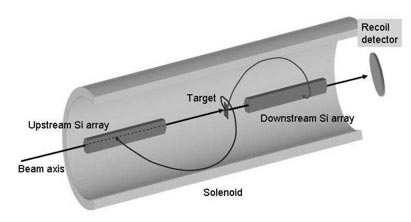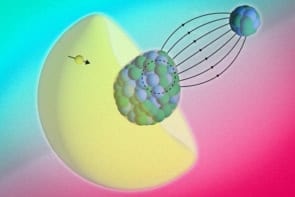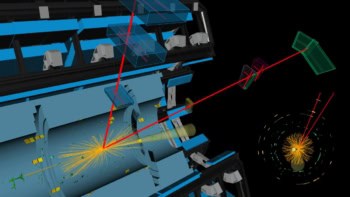
Nuclear physicists at the Argonne National Laboratory in the US have obtained the first results from a new spectrometer that contains the magnet from a mothballed MRI machine. They used the Helical Orbit Spectrometer (HELIOS) to make the most precise measurements to date of two excited states of boron-13 – an “exotic” nucleus containing an unusually high ratio of neutrons to protons. The researchers say that HELIOS could eventually yield precise data on the structure of a range of rare nuclei.
Carried out at Argonne’s ATLAS facility, the experiment involves slamming a beam of stable boron-11 nuclei, containing five protons and six neutrons, into a gas cell filled with much lighter deuterium nuclei, which have just one proton and neutron. This method of rare-isotope production – known in the trade as “inverse kinematics” – leads to neutrons being “stripped” from the deuterium and tacked onto the nuclei in the beam. The result is a “secondary” beam of short-lived boron-12 nuclei containing seven neutrons.
A subsequent stripping reaction takes place inside the magnetic field of HELIOS, built from a converted 2 m long superconducting solenoid donated to Argonne by the Max Planck Institute in Germany. The boron-12 beam is then passed into the magnet’s hollow centre, where it hits a target of thin deuterium-rich foil, from which another neutron is stripped to produce the desired boron-13 nuclei. By studying the protons left behind from the stripped deuterium nuclei, the researchers were able to gain insights into the boron-13 nuclei.
The advantage of HELIOS is in how it handles these protons, which are caught by the solenoid’s strong 3 Tesla magnetic field before being bent and focused back into a bank of silicon detectors along the beam axis. In similar experiments that rely on spectrometers with no magnetic fields, the protons cannon off the target at various angles, requiring expensive umbrella arrays of detectors to capture all information about a given reaction. And even with such arrays in place, the rapid variation in proton energies in such experiments makes it difficult to record precise measurements, particularly for those protons downstream from the target.
Sniffing out rare nuclei
Using HELIOS, the researchers were able to discern the spin quantum numbers of two such states less than 200 keV apart, a hair’s breadth on the nuclear scale. The data are key to determining the gap between the neutron shells that models suggest provide the essential structural scaffolding of all nuclei. However, much more significant than this first finding is the possibility of using HELIOS to investigate heavier neutron-rich isotopes such as tin-132 (50 protons, 82 neutrons).
“It wasn’t this measurement that the device was built for,” says Argonne physicist John Schiffer, who first proposed the idea of a HELIOS-type spectrometer about decade ago.
HELIOS is able to resolve protons with energies that differ by a mere 50–100 keV, whereas existing spectrometers have resolutions of just 150–250 keV. Birger Back, who is a member of the team that includes researchers from Manchester, Michigan State and Western Michigan universities, says that this three- or four-fold boost in resolution is an amount that “in many cases can either make or break an experiment”.
A related HELIOS benefit, say Back and Schiffer, is its high “efficiency”, which means that it can sniff out and make measurements for a higher percentage of rare nuclei produced during the experiment. This is important, says Wilton Catford, a nuclear physicist at Surrey University in the UK, “because the most interesting radioactive beams will always tend to be the rarest ones, with quite low intensities”.
Although Catford is not part of the HELIOS collaboration, he helped to develop two detectors – TIARA, currently based at the GANIL lab in France, and SHARC, at the TRIUMF facility in Canada – used in similar experiments with exotic beams. He says that, along with TIARA and SHARC, “the HELIOS detector provides one promising way to push the efficiency limits”.
The work is described in Physical Review Letters.



